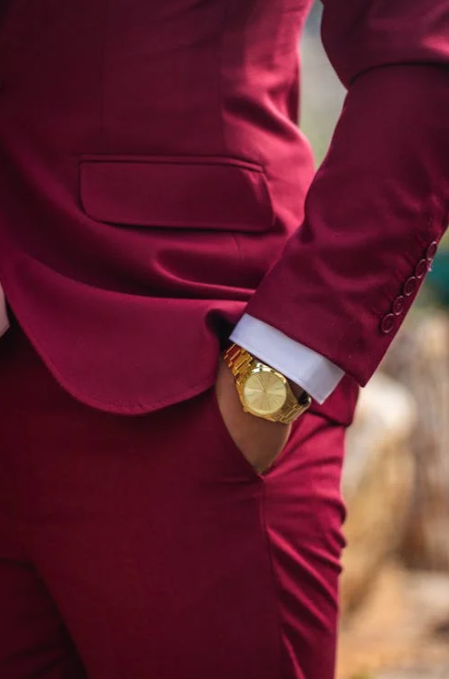
Written by Ben Chuang
Wearing a watch is more than just a practical way to keep track of time; it’s a statement of style and personality. However, achieving the perfect watch fit can be tricky.
A watch that’s too tight can cause discomfort, while a loose watch may feel awkward and unpolished. This article explores the nuances of finding the right fit for your watch, with attention to watch straps, materials, and personal preferences. And if you dislike the feeling of a strap around your wrist, you can always wear a pocket watch.

The Basics of Proper Fit
Comfort and functionality are key considerations when determining how tight a watch should be. The watch should sit snugly on your wrist without pinching the skin or leaving deep marks. A properly fitted watch stays in place but allows for natural wrist movement.
Whether you wear a watch with a traditional watch or a sleeker 38mm watch, the perfect balance between snugness and flexibility is essential for both comfort and style.
The Role of Personal Preference

Preference plays a significant role in determining how tight a watch should be. Some people prefer a snug fit, which ensures the watch stays firmly in place, while others enjoy a slightly looser fit for a more relaxed feel.
Factors such as wrist size, daily activities, and even climate can influence individual preferences. Ultimately, the right watch fit should make you feel comfortable and confident.
Testing the Fit with the Index Finger Rule
A simple way to check if your watch is too tight or too loose is by using the index finger test. Slide your index finger between the strap and your wrist. If it fits comfortably without excessive effort, your watch is likely at an optimal tightness.
If the finger struggles to fit, the strap may be too tight. Conversely, if there’s too much space and the finger fits too easily, you might need to tighten the watch band.
The Impact of Strap Materials on Fit
The material of the strap significantly affects how tight or loose a watch feels. For example, fabric or leather straps are often more forgiving and may stretch slightly over time, allowing for a more flexible fit.
Leather straps, in particular, can mold to the shape of your wrist, providing a custom feel that also looks great with skinny-fit dress shirts.
In contrast, metal watch bracelets are more rigid and require precise adjustments to achieve the desired fit. Understanding the characteristics of your watch’s material is crucial for achieving long-term comfort.
Balancing Snugness and Flexibility
The perfect fit strikes a balance between snugness and flexibility. A watch that is too tight can restrict circulation and become uncomfortable, especially during long periods of wear.
On the other hand, a loose watch may slide up and down your wrist, which can be distracting and impractical when wearing a formal dress shirt.
The ideal fit ensures the watch stays in place while allowing for natural wrist movement, providing both comfort and functionality.
Adjusting Watch Bracelets

Metal watch bracelets often come with adjustable links or micro-adjustment options. These features allow wearers to achieve a more precise fit. Check out our favorite affordable watches if you're in the market for luxury watches under $800.
To ensure your bracelet fits correctly, aim for a snug fit that still allows for the index finger test. Having the correct fit is especially important if you wear long-sleeved collared shirts, as a tight band may snag against the shirt cuff.
Adjusting the bracelet to accommodate your wrist size can make a significant difference in comfort and wearability. If needed, consult a professional jeweler for assistance with resizing.
Factors Influencing Tightness
Several factors influence how tight a watch should be, including wrist size, activity level, and the type of strap or bracelet.
For active individuals, a slightly tighter fit may be beneficial to prevent the watch from moving excessively during exercise or manual tasks.

For those in office settings, a looser fit may be more appropriate when paired with a button-down dress shirt. Additionally, the choice of fabric or leather straps versus metal bracelets can affect the overall feel and adjustability of the watch.
Seasonal Changes and Fit Adjustments
Seasonal changes can significantly impact how a watch fits on your wrist. Warmer temperatures often cause your wrist to swell, making a tighter watch feel restrictive and uncomfortable. Conversely, during colder weather, your wrist may contract slightly, which can result in a looser fit with your winter attire.
To maintain consistent comfort, it’s important to regularly check and adjust your strap or bracelet as the seasons change.
Opting for a watch with easily adjustable straps or bracelets is particularly useful for accommodating these natural variations. Additionally, some materials, like fabric or leather straps, may adapt better to these changes, while metal watch bracelets might require more deliberate resizing.

Common Fit Mistakes to Avoid
One common mistake is wearing a watch too tightly, which can lead to discomfort, restricted circulation, and even skin irritation over time. On the other hand, wearing a watch that’s excessively loose can cause it to slide around your wrist, making it cumbersome and increasing the risk of damage to the watch strap or bracelet.
These mistakes are often the result of neglecting to regularly test and adjust the fit of your watch. By using simple methods, such as the index finger test, you can avoid these pitfalls and enjoy a more comfortable and functional experience.
A well-fitted watch not only looks better but also extends the lifespan of your watch strap, whether it’s made of fabric, leather, or metal. Don't forget to learn more about outfit and watch band pairings in our guide on how to wear a watch.

Achieving the Perfect Fit
Achieving the perfect fit involves more than just securing the strap around your wrist. How tight should a watch feel is a question that requires consideration of several factors, including personal preference, strap material, and seasonal changes.

Whether you prefer the flexibility of fabric or leather straps or the sturdiness of a metal watch bracelet, the goal is to ensure the watch fits in a way that complements your lifestyle. Make adjustments as needed, and don’t hesitate to seek professional help to resize complex bracelets. By taking the time to find the ideal balance between snugness and flexibility, you can elevate both the comfort and the overall experience of wearing your watch.
Understanding how tight a watch should be is essential for formal and casual wear. By following the index finger test, considering personal preferences, and paying attention to the materials of your watch strap or bracelet, you can achieve a fit that’s just right.

Whether you prefer the classic elegance of a leather strap or the modern appeal of a metal bracelet, the key is to strike a balance between snugness and flexibility. With proper adjustments and regular checks, your watch will not only look great but also feel comfortable throughout the day.
FAQs about How Tight Should a Watch Be
Should a watch be tight or slightly loose?
When it comes to how tight should a watch be, go for slightly loose rather than overly tight to provide a comfortable wearing experience. It should sit securely on your wrist without pinching the skin or restricting blood flow.
A tight watch can leave marks on your wrist and feel uncomfortable over time, especially during long periods of wear. On the other hand, a watch that is too loose may slide excessively, making it inconvenient to check the time and potentially causing wear and tear on the strap.
How many fingers should fit under your watch?
As a rule of thumb, one finger should fit comfortably under the strap of your watch when it’s fastened around your wrist. This guideline is great for determining how tight should a watch be. A strap that doesn’t allow any finger space may feel restrictive and cause discomfort, especially if your wrist expands slightly throughout the day due to temperature changes or physical activity.
Conversely, if more than one finger fits under the strap, the watch is likely too loose and may slide around your wrist, which can be both distracting and impractical.
Where should a watch sit on your wrist?
The correct placement for a watch is just above the wrist bone, also known as the ulna, on the side closer to your hand. This position is considered ideal for both comfort and practicality.
Wearing the watch in this spot prevents it from sliding too far up your arm or sitting too low on your hand, which could interfere with activities such as typing or writing. How tight should a watch be also depends on whether you have leather or fabric straps.
How tight should a Rolex be?
A Rolex, like any high-quality watch, should fit snugly on your wrist without feeling overly tight. But how tight should a watch be? Ideally, you should be able to slide one finger between the bracelet and your wrist to confirm the fit is comfortable.
How tight a watch should be is also a matter of preference. On the other hand, a Rolex that is too loose may slide excessively, making it difficult to read the time and increasing the risk of accidental damage.




Comments (0)
Back to News